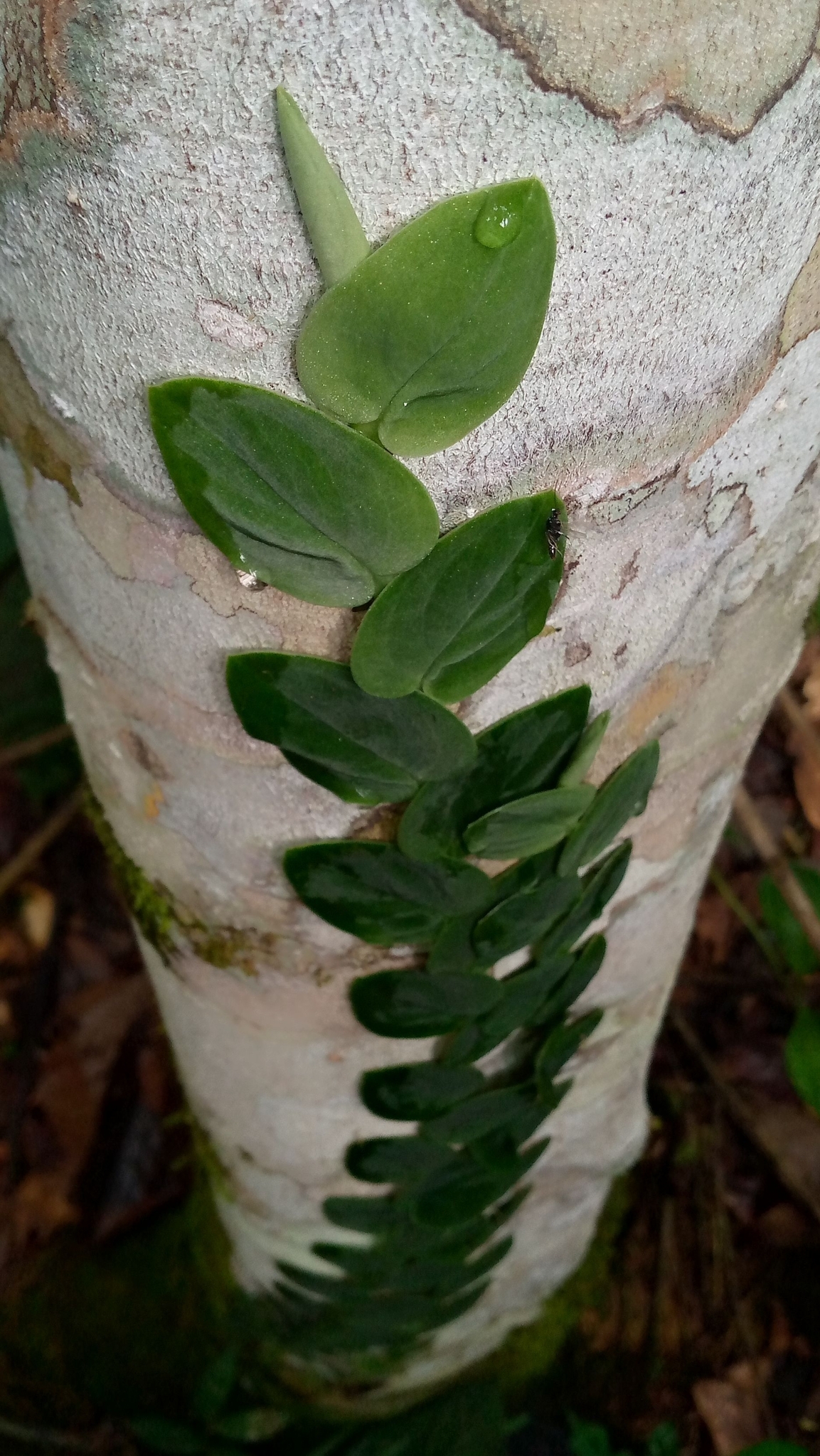Monstera aureopinnata
#热植图鉴#热带loveplants2024-05-03
Monstera aureopinnata,热带植物,天南星科,龟背竹图鉴,热带loveplants
 基本信息 General Information
Accepted Name:Monstera aureopinnata Croat
首次发布于:Rodriguésia 56: 92 (2005)
中文名称:龟背竹
科:天南星科
属:龟背竹属
原产地:哥伦比亚、厄瓜多尔、秘鲁
命名者:Croat
植物简介 Descriptions
贴生攀援半附生植物;成年植株的节间短于宽,直径达 2 - 2.5 厘米,未成年植株的节间长于宽且长达 3 厘米,表皮干燥后呈黄褐色,半有光泽,有明显的纵向折叠脊和横向裂缝。叶直立伸展,叶柄比宽处厚,长 29 - 44 厘米,干燥后有细棱,自由部分厚 6 - 8 毫米,正面有槽,呈灰绿色、灰棕色至深黄褐色,叶鞘长 13 - 26 厘米,为其长度的 0.36 - 0.78%;叶鞘持久完整;叶节长 2.5 厘米,干燥后比叶柄颜色深;叶片羽状分裂,通常不均匀,羽片数量不等或羽片宽度差异很大,44 - 58×19 - 26(40)厘米,长为宽的(1.4)2 - 2.6 倍,比叶柄长 1.3 - 1.9 倍,干燥后上面为灰色至灰绿色至黄褐色,下面通常为浅至中等黄褐色,较少为深黄褐色;羽片 3 - 6 对,宽 1 - 7.1 厘米,裂片中部比收缩部分宽 1.2 倍,在叶轴上下基部宽下延,羽片最宽部分总是在基部(从两个下延边测量),这部分宽度可达远端任何部分最宽处的两倍;最下面的羽片有时近基部二分叉;每个羽片有 1 - 4 条初级侧脉,干燥后上面同色至稍浅且微凹,下面窄隆起且颜色较浅;上表面微弱且细微颗粒状,主脉干燥后稍浅,平坦或微凹;下表面干燥时有细脉,大多紧密平行,偶尔有斜向连接(特别是靠近边缘),针晶体细胞在细脉之间清晰可见为隆起线,偶尔可见短的白色线状细胞内含物,高倍放大下微颗粒状。花序成簇出现,最多 3 个;
基本信息 General Information
Accepted Name:Monstera aureopinnata Croat
首次发布于:Rodriguésia 56: 92 (2005)
中文名称:龟背竹
科:天南星科
属:龟背竹属
原产地:哥伦比亚、厄瓜多尔、秘鲁
命名者:Croat
植物简介 Descriptions
贴生攀援半附生植物;成年植株的节间短于宽,直径达 2 - 2.5 厘米,未成年植株的节间长于宽且长达 3 厘米,表皮干燥后呈黄褐色,半有光泽,有明显的纵向折叠脊和横向裂缝。叶直立伸展,叶柄比宽处厚,长 29 - 44 厘米,干燥后有细棱,自由部分厚 6 - 8 毫米,正面有槽,呈灰绿色、灰棕色至深黄褐色,叶鞘长 13 - 26 厘米,为其长度的 0.36 - 0.78%;叶鞘持久完整;叶节长 2.5 厘米,干燥后比叶柄颜色深;叶片羽状分裂,通常不均匀,羽片数量不等或羽片宽度差异很大,44 - 58×19 - 26(40)厘米,长为宽的(1.4)2 - 2.6 倍,比叶柄长 1.3 - 1.9 倍,干燥后上面为灰色至灰绿色至黄褐色,下面通常为浅至中等黄褐色,较少为深黄褐色;羽片 3 - 6 对,宽 1 - 7.1 厘米,裂片中部比收缩部分宽 1.2 倍,在叶轴上下基部宽下延,羽片最宽部分总是在基部(从两个下延边测量),这部分宽度可达远端任何部分最宽处的两倍;最下面的羽片有时近基部二分叉;每个羽片有 1 - 4 条初级侧脉,干燥后上面同色至稍浅且微凹,下面窄隆起且颜色较浅;上表面微弱且细微颗粒状,主脉干燥后稍浅,平坦或微凹;下表面干燥时有细脉,大多紧密平行,偶尔有斜向连接(特别是靠近边缘),针晶体细胞在细脉之间清晰可见为隆起线,偶尔可见短的白色线状细胞内含物,高倍放大下微颗粒状。花序成簇出现,最多 3 个;
该物种的特征是呈黄褐色干燥、羽状浅裂的叶片(因此有“aureopinnata”这一名称),叶片裂至基部,裂片基部在叶轴上向两个方向显著下延。尖锐的雌蕊和橙色至红色的浆果也是其特征。
Appressed-climbing hemiepiphytic; internodes shorter than broad on adult plants, to 2–2.5 cm diam., longer than broad and to 3 cm long on preadult plants, epidermis drying yellow-brown, semiglossy, conspicuously longitudinally folded-ridged and transversely fissured. Leaves erect-spreading with petioles thicker than broad, 29–44 cm long, drying finely ribbed, 6–8 mm thick on free portion, sulcate adaxially, greenish gray, grayish brown to dark yellow-brown, sheathed 13–26 cm, 0.36–0.78% its length; sheath persistent intact; geniculum 2.5 cm long, drying darker than the petiole; blades pinnately lobed, usually unevenly with an unequal number of pinnae or pinnae of much different widths, 44–58 × 19–26(40) cm, (1.4)2–2.6 times longer than wide, 1.3–1.9 times longer than petioles, drying gray to gray-green to yellow brown above, usually pale to medium yellow brown below, less frequently dark yellow brown below; pinnae 3–6 pairs, 1–7.1 cm wide, the middle of the lobe 1.2 times wider than the constricted portion, broadly decurrent at base both up and down the rachis, the broadest portion of the pinnae always the very base (as measured from the 2 decurrent sides) this being up to twice the width of the broadest part of any portion distally; the lowermost pinnae sometimes bifurcated to near the base; primary lateral veins 1–4 per pinnae, drying concolorous to slightly paler and weakly sunken above, narrowly raised and paler below; upper surface weakly and minutely granular, with major veins drying slightly paler, flat or weakly sunken; lower surface drying with minor veins, mostly closely parallel, with occasional oblique interconnectivity (especially toward margins), raphide cells clearly visible as raised lines between the minor veins with occasional short white linear cellular inclusions visible, weakly granular on high magnification. Inflorescence arising in clusters of up to 3; peduncles 7.5– 9 cm long, drying 5–7 mm wide, dark to light yellow-brown, matte, finely striate; spathe 12–22 cm long, 1.4–2 times longer than spadix, drying yellow-brown to dark reddish brown; spadix yellow-orange (post-anthesis) 9.5–15 cm long; pistils ca. 3 mm long, drying with the ovary ca. 1 mm wide, the style 1.5 mm diam., dark brown, minutely papillategranular, matte, acute with the stigma borne at the apex and slightly wider than the dried style; stigma 0.6 × 0.3 mm, depressed medially with pale brown raised margin; stamens free, ca. 2 mm long on drying, the thecae 1.2 mm long, oblong, closely parallel, the filament flattened. Infructescence to 21 × 3 cm on drying; berries obovoid, red to orange, acutely pointed, to 8 x 4–5 mm.
The species is characterized by yellowish brown drying, pinnately-lobed leaf blades (hence the epithet ‘aureopinnata’), which are lobed to the base with the basal portions of the lobes prominently decurrent in both directions on the rachis. Also characteristic are the acute pistils and the orange to red berries.
植物图片 Images

幼年期 Juvenility

生长期 Growth period

成熟期 Maturity



 图册
扩展阅读
参考资料
植物标本
图册
扩展阅读
参考资料
植物标本







